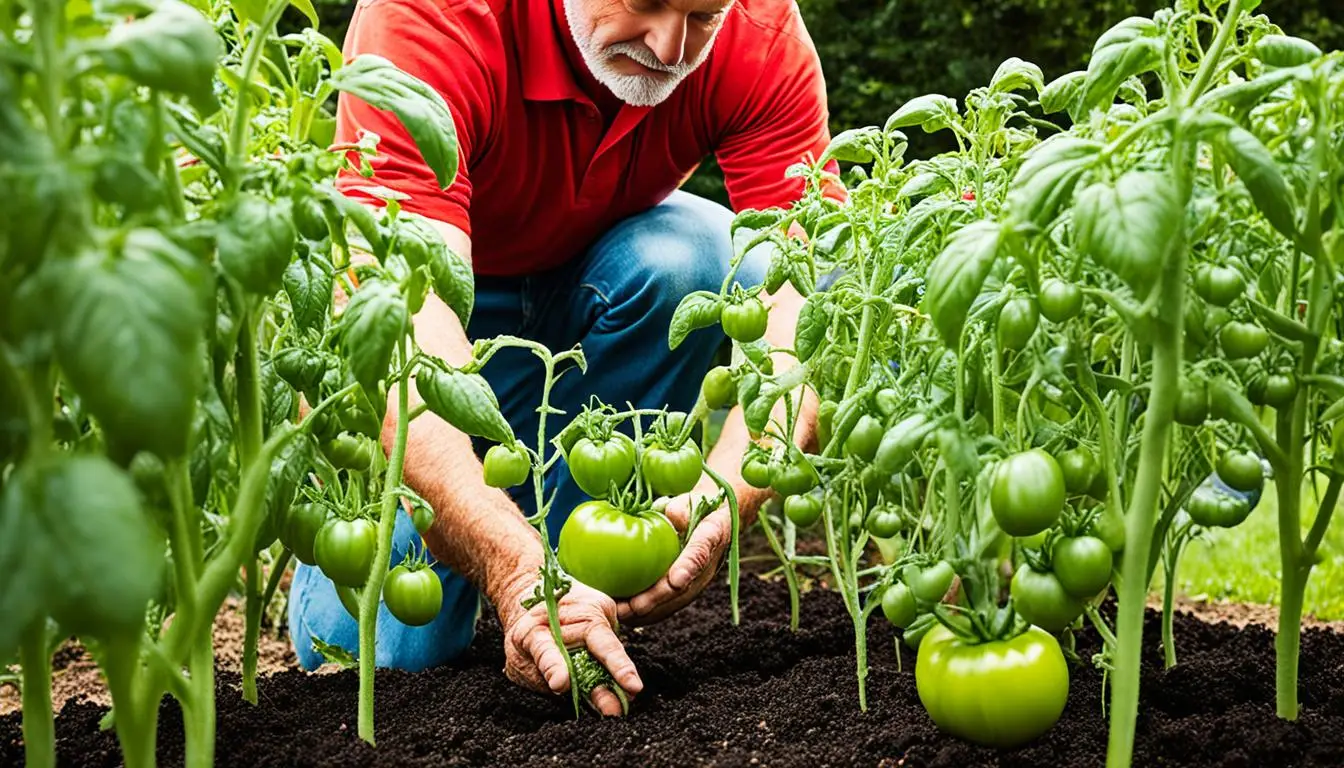The humble tomato is a must-have in any backyard garden. For growing the sought-after “Big-Boy” variety, getting fertilization right is crucial. This guide will give you the knowledge to feed your Big-Boy tomatoes well.
Key Takeaways
- Tomatoes need a mix of essential nutrients for best growth and fruiting.
- Right fertilization helps avoid nutrient shortages and blossom end rot.
- Using organic and homemade fertilizers is a green way to feed your tomatoes.
- When and how you apply fertilizers is key to getting nutrients to your tomatoes.
- Planting tomatoes with other plants and managing pests can help with fertilization.
Introduction to Growing Big-Boy Tomatoes
Looking to add juicy, flavorful tomatoes to your garden? Consider growing Big-Boy tomatoes. These hybrid plants are loved for their size, resistance to pests and diseases, and high yields. To get a great harvest, know what these plants need and pick the best spot for them.
Understanding the Growing Requirements
Big-Boy tomatoes love warm, sunny spots and prefer soil that drains well and is a bit acidic. They keep growing and producing all season, so they need support like stakes or cages. Make sure to plant them 36 inches apart for good air flow and easy picking.
Choosing the Right Planting Location
Pick a spot for your Big-Boy tomatoes that gets 6-8 hours of sunlight a day. Stay away from shady or crowded areas that could slow down the plants. Also, make sure the area is safe from pests and diseases that could harm your tomatoes.
By knowing what these plants need and picking the right spot, you’ll set your Big-Boy tomatoes up for success. Enjoy a season full of delicious, juicy tomatoes.
Nutrient Needs of Big-Boy Tomatoes
Tomatoes are heavy feeders and do best with lots of nutrients. They need a balanced diet of essential nutrients to grow well. Knowing what your big-boy tomatoes need can help keep your garden healthy and productive.
Essential Nutrients for Tomato Plant Growth
Tomato plants need nitrogen (N), phosphorus (P), and potassium (K) for growth and fruit. These nutrients are key for the plant’s health:
- Nitrogen (N) helps with green leaves and strong plants.
- Phosphorus (P) helps roots grow, flowers bloom, and fruits develop.
- Potassium (K) makes the plant strong and fights diseases.
Tomatoes also need calcium, magnesium, and trace elements like iron, boron, and zinc to do well.
Signs of Nutrient Deficiencies
Watching your tomato plants closely can show you if they lack nutrients. Look for signs like stunted growth, yellow leaves, blossom end rot, and less fruit. Fixing these issues quickly can help your tomatoes grow well.
| Nutrient Deficiency | Visible Symptoms |
|---|---|
| Nitrogen (N) | Yellowing of older leaves, stunted growth |
| Phosphorus (P) | Purple or reddish leaves, late maturity |
| Potassium (K) | Scorched or curled leaf edges, small fruit |
| Calcium | Blossom end rot, uneven fruit growth |
| Magnesium | Yellowing between leaf veins in older leaves |
Knowing what tomatoes need to grow and how to spot nutrient problems helps gardeners. This way, your big-boy tomatoes get what they need to grow big and taste great.
Fertilizing Big-Boy Tomatoes: What You Need to Know:
Feeding your Big-Boy tomato plants right is crucial for a healthy and abundant harvest. You can choose from organic or synthetic fertilizers to give your tomatoes the nutrients they need for growth and fruiting.
Types of Tomato Fertilizers
Organic fertilizers like manure, compost, wood ashes, Epsom salts, banana peels, and coffee grounds are great for your tomatoes. They boost leaf, root, and fruit growth. These natural options also make the soil better at holding water and nutrients.
Synthetic tomato fertilizers are another choice. Look for ones with the right mix of nitrogen, phosphorus, and potassium. Adding a starter food high in phosphorus to the soil when you plant can help roots and shoots grow strong.
When to Fertilize Tomato Plants
Give your plants another feeding when you see the first fruits. A side dressing of calcium nitrate a few weeks after planting can also help. It makes the fruit cell walls strong, preventing blossom end rot. Feeding your plants at the right times is key for their health and yield.

“Fertilizing your Big-Boy tomatoes at the right time and with the right nutrients can make all the difference in the quality and quantity of your harvest.”
Organic and Homemade Fertilizer Options
Using organic and homemade fertilizers can really help your big-boy tomatoes grow. These natural options feed your plants and make your garden healthier and more sustainable.
Wood ashes are great for adding potassium to your tomatoes. They help with growth and fruit production. Epsom salts prevent magnesium shortages and keep leaves from turning yellow.
Chopped-up banana peels give your tomatoes a potassium boost. And don’t forget about coffee grounds. They have about 20% nitrogen, making them a top-notch fertilizer.
You can mix these organic additives into the soil before planting or use them as side dressings later. Making your own tomato fertilizers is a smart way to feed your plants with natural stuff.
“Organic gardening is not just a fad – it’s a holistic approach to growing healthy, nutritious food while respecting the delicate balance of our ecosystems.
| Organic Fertilizer | Nutrient Contribution |
|---|---|
| Wood Ashes | Potassium |
| Epsom Salts | Magnesium |
| Banana Peels | Potassium |
| Coffee Grounds | Nitrogen |

Adding these easy-to-find organic fertilizers and soil amendments to your tomato care routine helps your plants grow naturally. It also supports a healthy, earth-friendly garden.
Conclusion
Fertilizing your big-boy tomatoes right is key to getting lots of fruit and high quality. Knowing what nutrients they need, the types of fertilizers out there, and when to use them helps your tomatoes grow well. Whether you pick commercial, organic, or homemade fertilizers, make sure they give your plants balanced nutrients all season.
Right fertilization practices mean you can have a lot of tasty big-boy tomatoes. Stay away from fertilizer mistakes and aim for tomato yield maximization in your tomato gardening. By giving your plants the right fertilizer requirements and nutrient needs, you’ll get better yield and quality. This makes your tomato growing guide very successful.
The secret to growing great big-boy tomatoes is careful tomato plant fertilizers and knowing what they need. With this knowledge, you can make your tomato crop reach its full potential. Enjoy the fruits of your tomato yield enhancement work.
FAQ
Can tomatoes be grown in patio containers?
Yes, tomatoes can grow well in patio containers. Make sure the pot is big enough and it gets full sun. Use stakes or cages to help the plants grow tall. Remember, containers dry out fast, so keep an eye on the water.
How far apart should tomato plants be spaced when planting in the ground?
Plant tomatoes 24 to 36 inches apart in the ground. Keep each row 48 inches apart to stop diseases from spreading.
What are the ideal growing conditions for Better Boy tomatoes?
Better Boy tomatoes love a bit of acidic soil (pH 6.5-7.0) and full sun. Plant them after the last frost. Start them indoors 6-8 weeks before moving them outside. Keep them 36 inches apart for better air flow and easy picking.
What are the essential nutrients needed for tomato plants?
Tomatoes need nitrogen, phosphorus, and potassium (NPK) for growth. They also need calcium, magnesium, and trace elements. Test your soil’s pH before planting and adjust it if needed. Aim for a pH of 5.5-7.
What are some signs of nutrient deficiencies in tomato plants?
Look out for stunted growth, yellow leaves, blossom end rot, and less fruit. These are signs that tomatoes might not have enough nutrients.
What types of fertilizers can be used for tomatoes?
You can use both organic and synthetic fertilizers for tomatoes. Organic options include well-rotted manure, compost, and banana peels. Synthetic fertilizers should have the right mix of nitrogen, phosphorus, and potassium.
When should tomato plants be fertilized?
Add a starter food with lots of phosphorus at planting to help roots and shoots grow. Feed the plant again when you see the first fruits. A calcium nitrate side dressing a few weeks later can strengthen the fruit.
What organic items can be used to enhance tomato growth and production?
Wood ashes give tomatoes potassium, Epsom salts help with yellow leaves, and banana peels add potassium. Coffee grounds have 20 percent nitrogen. Use these in the soil before planting or as side dressings during the season.






